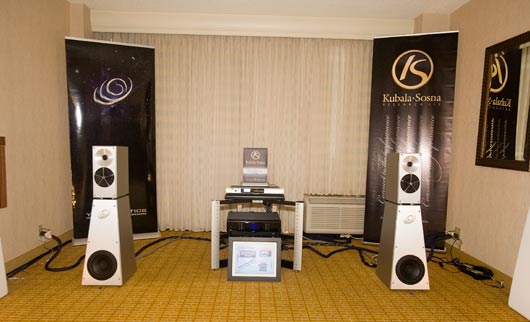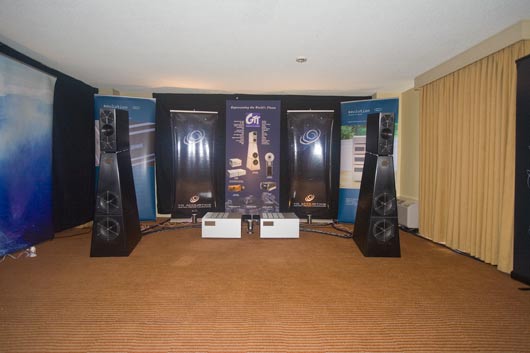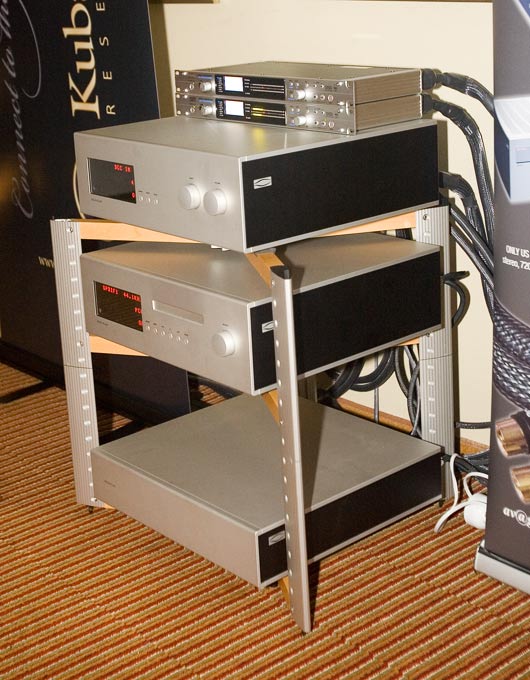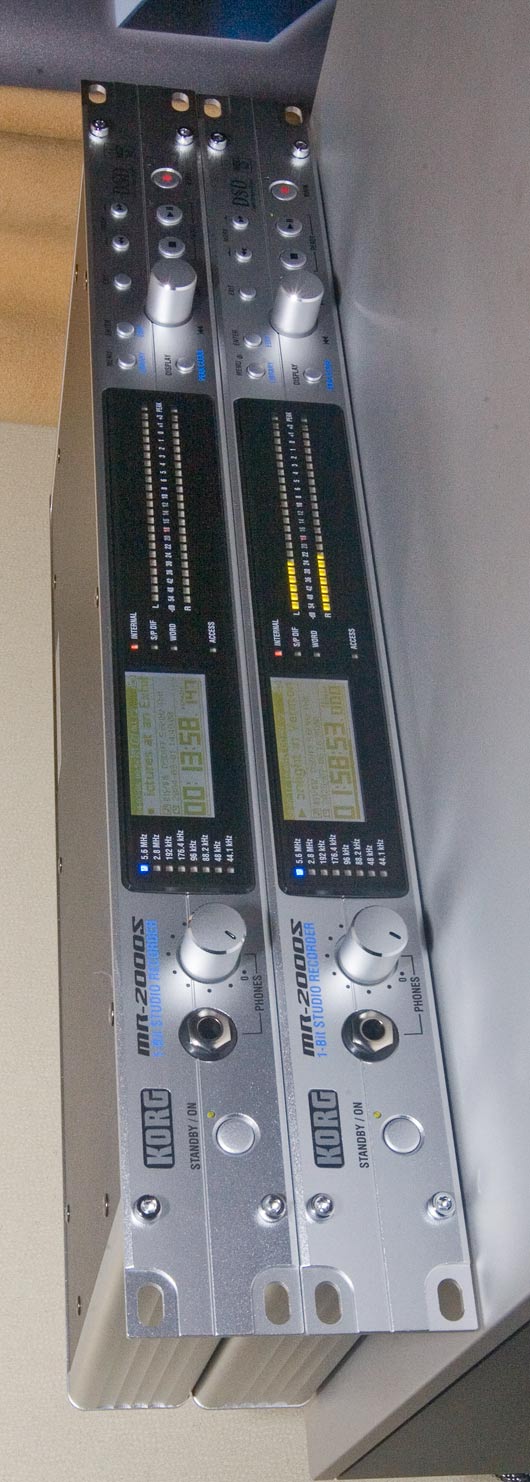YG Acoustics at RMAF 2010
YG Acoustics speakers of various sizes were found in 3 different rooms [at least].
There are a few interesting things to say about these rooms, I think, but in the future we will likely not talk much at all about YG Acoustics because they, or the rooms and people that use them, are too often just going for Practical or Boy Toy systems – and these just do not interest me, no matter if the speakers are worthy of much more [as many other speakers are as well].
At their best [on big old Krell amps, which I heard them with several years ago and I hear they ran them with again at the Dagogo show], these are speakers with a very linear response. Not perfect in all aspects, but speakers very worth listening to. Put something soulful up front [instead of the Krell Pre and dCS they usually use] and a person could well achieve a Drug-like intoxicating soul-expanding sound.
None of these rooms gave any indication that the speakers might be able to do this. Kind of like Wilson in that respect; if you were to go by the sound in most rooms that use Wilson speakers at most shows [and I guess most if not all dealer showrooms], you’d think they were a bad sounding, in-your-face, its-all-about-marketing speaker.

ROOM 1: This was the best sounding room with the YG Acoustics if you value musicality, listenability, and to a large degree accuracy and true-to-the-source realness.
The MBL integrated amp used in this room was relatively modest [100 – 150watts range if I remember correctly], and the fallout from this choice in amplification (a choice made in order to keep this a modest, balanced system [but there is no law that says the amps can’t be larger and several times as expensive as the speakers :-); MBL makes many beefier and very heavy amps which would be very interesting to hear on these little speakers]) was that the dynamics of the midrange was quite a bit less … dynamic… than that of the self-powered bass. So there was a disconnect between the mids and bass and it was much like a satellite speaker with a very tightly controlled subwoofer [subwoofers with aluminum cabinets like these… now THAT is subwoofering :-)].
One of the more interesting things at the show this year was the source in this and the next YG room. They recorded LPs [a few scratches and pops too :-)] onto digital and were using this pre-recorded digital music as their source.
It 1) DID retain some of the analog magic and 2) the ways in which it was not exactly like the original analog showed exactly how far digital recording and playback has yet to go if it is going to be at all convincingly like the music it is recording.
The quality of the pre-recorded LP playback is way better than the iPod playback components (which I saw NONE of this year – hurray! – and we instead saw a lot of reel-to-reel tape decks [Yay! but is this cheating? How many people have R2R in their systems?]). The LP playback was not as good as good CD playback, but it did manage to reproduce a little of the natural bloom and some of the PRaT [not exactly what I mean. There was a dynamic flow between the notes that was LPish, but there was also a stark discontinuousness that was unlike CD or LP] and a little of that harmonic richness that is found on [most] LPs.

ROOM 2: This was the GTT Audio room with big YG Acoustics and Soulution electronics and the LP-on-digital source we talked about above.
This system was much the same as last year, with the exception of the source now having pre-recorded LPs instead of… pre-recorded CDs(?) last year. This is your standard Boy Toy system [as we talked about many times before, amps like the Soulution, despite its name, are not useful outside of the Boy Toy type system because of their lack of micro-dynamics etc.].
Maybe someday we will rank these but for the present they are not all that interesting to me. Sure am curious why SO MANY of these types of systems are foisted on us – it is like as a group the high-end audio industry has decided that only Boy Toy-loving audiophiles want big dynamics, or perhaps it is that most have decided that ALL audiophiles are looking for Boy Toys, and those that have limited funds get small Boy Toy systems and those that are more wealthy get BIG Boy Toy systems.

The Soulution front end.

The equipment used to record? and playback the pre-recorded LPs

ROOM 3: The Veloce room also had small YG Acoustics speakers.
The Veloce electronics has a sweet, pleasant family sound. What was interesting, to me, here was that the sound was so … ordinary… by which I mean it sounded like your typical room at the show. Much of the linearity and resolution of these speakers was not in evidence [I believe many of the people who favor Practical systems think that this is probably a good thing].

Close up of the equipment rack.

Close up of the little YG Acoustics speakers.

You made an interesting point with large BOY TOY systems and small BOY TOY systems. But what about small DRUG systems? Is the DRUG like quality only achievable with ultimately expensive components, or are there systems around that still offer the magic, but sacrifice something else instead (say bass extensions or top sound pressure)?
In earlier posts you were comparing the intoxicating qualities of some very expensive systems to drinks of alcohol (from beer to wine to single malt?) In order for people to start getting interested in better music reproduction there have to be components that have soul, but do not cost the earth. Something equivalent to a small glass of single malt: you get the nice taste, that leaves you longing for more.
Hi umea101,
Well, that is an incredibly interesting question. I certainly find Grant Fidelity ($6K this year at RMAF) and the lesser priced Epos, Creek, Music Hall and Odyssey rooms are often quite Enjoyable.
So the question is how to make a system, any system, into a DRUG system. We can give it more soul, but is that enough? Or it it even required?
OK. More later. Got another audition in 15 minutes. Oh, and how expensive is ‘expensive’? 🙂
Take care,
-Mike
Hi!
Expensive depends of course on your income and how much you are willing to sacrifice to fund the audio habit. As a dealer you should be interested in getting people hooked on good sound. This happened for me already in high school: I was working summers and could afford to build a nice stereo system. Then of course I was living with my parents and all of my income was disposable.
Earlier you wrote about “soul” of a system as the ability to convey emotion. This is very important for me if the system is to act as a drug. Shivers down the spine definitely help me to get into a music induced high.
As for how to achieve this, I would put a high quality source very high on the list. This might have something to do with my own audio journey. Everything from speakers to amp and cabling has stayed the same in my system for the last eight years. Each level of upgrade in the source (digital) made the system more drug like. Maybe I was lucky with the choice of components and they permitted all the goodness of the source to pass through.
Hi umea101,
Well, yeahhhh, that is everyone’s definition of affordable. I was thinking of a more concrete thing. Like a number. I think we will say $10K is kind of the baseline for a system that one can kind of work with and make more and more drug-like over time.
Yes, we try to sound our best here, and although most people fight it really hard [we get mostly very smart people up here :-)] they do tend to weaken and falter, getting hooked, more hooked, or re-hooked… and I think we get as many wives hooked as husbands. People do have a tendency to say ‘Oh, well, it sounds great but for that price, it ought to sound great.’ but of course as we all know, it doesn’t [have to sound great at all, even if it is expensive].
Thanks! That is an interesting approach and kind of fits in with the idea of a ‘decent’ baseline system that has a few attributes that is(are) very special in relation to he rest of the system. This approach may not pan out – but I think it is worth thinking about the issues…
Take care,
-Mike
Hi!
I guess 10k$ is as good a sum as any. I probably was a little simplistic thinking about the importance of the source. If we view the audio chain as an information transmitting system, the information has to be there in the first link. What is lost at the source cannot be recovered otherwise. And I am still talking about accuracy. Of course it is possible to make things more listenable, but probably at the cost of information thrown away. If you want “drug” out on one end you have to put “drug: in at the other end. Therefore the minimal requirement that the source should be capable of the appropriate drug level (say red wine…). If the source fails, any other downstream component will not recover this.
Ideally you would want to match information transmission properties of the components. Having chosen a source component you would want to use an amp (let’s skip cables for the moment) that transmits all the information of the source, not more (too expensive, if we equate transmission capability with price) but not less (“drugness” is lost). Ideally wyou would move like that down the chain. What this does not take into account is interaction between components (especially speaker/amp).
At a system building session you would need to first find a source, hook it up to the best system you can find and see if you like what you hear. One could then imagine swapping elements one at a time, say the cables from source to amp. Moving from expensive to cheaper cables you probably will notice at some price point a sharp decline in “drugness”. This is the point when the transmission abilities of the cable (or amp or speaker) limit the information flow, not the source anymore.
Practically I cannot imagine having enough time to do anything like that. Also all other variables like time of the day, mood, warm up of components have to be taken into account somehow.
Hi umea101,
Everything you say is true… and information flow correctly predicts that each component is the most important component. However:
The amount, A, of information we need from the source, and its makeup [what parts of the information are important] in order for a sound to be drug-like is not clear, but it is definitely not equal to 100% and some types of information [let’s say micro-dynamics] is more important to preserve than other types [say low level bass detail].
Second, if a person is going to spend anytime at all listening to a drug-like system, that person must be able to enjoy listening to that system. The speaker/amp choices determine the character of the sound to a very, very large degree.
So a person should first choose a speaker/amp combo that 1) suits their preferences and 2) is able to reproduce the parts of music that are important to obtain that drug-like sound [for now we will say at least micro-dynamics], 3) is the best they can afford
Then choose the cables that Do The Least Harm. This is actually much harder than it seems [and honest people have slightly different views on what is OK to harm and not OK to harm].
Then I would say get the best source you can afford.
And then periodic cascade upgrading: highest priority: source, then cables, then the amp IF the speakers can be pushed further, then finally new speakers/amps combos.
One thing we have learned with the Emm Labs XDS1 and Audio Note DAC 5 Signature, is that there is a LOT of information on CDs, WAY more than what I had always thought [and we had great digital eq. here before those]. And with the Nordost Odin [sorry for putting the brands here all the time, but some people may not be familiar with some of this stuff] we learned that there has been a LOT of information being discarded by our cables. WAY more than what I previous thought [and we had great cables here before those].
The point then is that there is more information we get to play with to make our drug-like experiences every day – and even if some of this extra information it turns out is NOT drug like [but some of it is!], it is always nice to have to kind of embrace and put into context the information that is. The other point is that getting that drug-like experience might not be all that expensive if one finds out exactly the minimal required information is in order to achieve it… and then puts together a system that only has to preserve this particular subset of vital information. Vladimir Lamm did research on things one might say are similar to this is the old USSR [bet they did NOT call it ‘drug like’ :-)] and I think Ed Meitner (of Emm Labs] mentioned something similar to this as well.
Take care,
-Mike